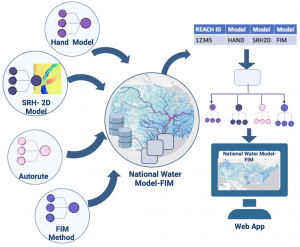Research Team: Karina Larco, Rollin Hotchkiss, Riley Hales, Andy Carter, David Maidment, Ibrahim Demir, James Halgren, Corey Crewson, Carson Pruit, Fernando Salas, Alan Zundel
Insitution: Brigham Young University, University of Texas, University of Iowa, University of Alabama, NOAA/NWS Office of Water Prediction at NWC, Aquaveo
Start Date: June 1, 2023 | End Date: May 31, 2024
Research Theme:

Flood Inundation Maps (FIMs) are crucial tools for managing disaster risks, but their effectiveness is hindered by a lack of standardized data structures. This study highlights the need for a common FIM-results data format to streamline collaboration and open the door to different models and methods for FIM generation in support of the National Water Model (NWM). The NOAA Office of Water Prediction (OWP) is leading the way in creating a national-scale FIM forecast using the Height Above Nearest Drainage (HAND) method through initiatives such as OWP-HAND FIM and RAS2FIM. Simultaneously, the US Army Corps has developed HEC-RAS models for 1D and 2D flood modeling, and the Federal Highway Administration (FHWA) recommends SRH-2D for hydraulic design.
This study outlines a comprehensive approach with five interconnected objectives. First, we seek to understand modeling practices and standard operation procedures to develop FIM across key agencies like the NOAA, US Army Corps of Engineers (USACE-CHL), and FHWA, as well as other stakeholders. Second, propose a standard “data model” for sharing results of models that lead to FIM. Objective 3 will explore the national expansion of the Tx-Bridge tool, leveraging LIDAR data and deep learning techniques to enhance FIM accuracy. Objective 4 will create initial FIM data archives using the standard data model, incorporating FIM generated from 2D hydraulic models and collaborating with various agencies. We will enhance visualization and communication tools like IFIS in Iowa, utilizing platforms like Tethys to facilitate effective FIM evaluation and analysis within research and operational communities, along with key stakeholders.
By creating a collaborative FIM data model and providing user-friendly tools, we hope to accelerate improvements to a national FIM and foster partnerships with organizations like FHWA and USACE. Our commitment to sharing findings and supporting researchers will improve FIM practices and create a stronger pathway from research to operations.